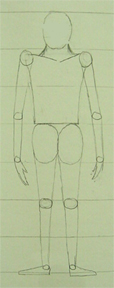Figure Drawing

After an introduction to the Renaissance via viewing and discussing the figures on the Sistene Chapel, students explored this section of the Timeline by learning a little about the original "Renaissance Man," Leonardo da Vinci. Many had expressed an interest in developing their "people drawing" skills, and we started with an overview of proportion, using Leonardo's "Vitruvian Man" image as a discussion starter.
I pointed out that a full-grown adult has different proportions than the average 7th grade student, but one student said that there was "no way" that the width of his arms could be anywhere CLOSE to the height of his body. To our mutual surprise, when we measured him we discovered that the width of his outstretched arms was almost EXACTLY the same number of inches as his height!
We then discussed the truth of "Learning to draw is really a matter of learning to see--to see correctly--and that means a good deal more than merely looking with the eye." (Kimon Nicolaides). I had the students look at each other from the front and from the side, and we noted that in most cases, people are wider across the front than they are from back to front. I held a styrofoam cup in my hand and flattened it slightly, showing that it resembled the human body, from the shoulder area to the waist. I said that we'd call this a flattened "bucket" and they could draw this shape to represent the upper part of the torso.
I had them stand up to notice where there elbows and wrists were in relation to their waist, and they drew small circles to represent these joints. We continued with these guided skill-building exercises, using "head-heights" as a our measuring standard. They drew several imaginary figures using tubes, "buckets," ovals and circles, and then they took turns posing and drawing each other in this analytical way.

Following these exercises, students drew a grid on drawing paper, and then drew a corresponding grid on a photograph, using a photograph from a magazine as a reference. They carefully "plotted points" to transfer the magazine image to their drawing paper, focusing more on the overall form than on details. They were quite pleased with their results, and some of these 7th grade students said that these were the best drawings of people they'd ever done. I was pleased with their results, too!


